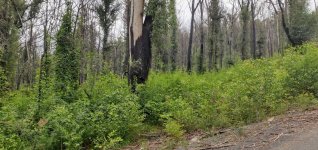I'm in SE NSW, Australia on 50 sloping acres. I'm hoping to clear around 15 acres out of the 50.
I have been looking at ~50hp tractors with backhoe/grader/heavy duty slasher attachments for these tasks. An alternative method I'm thinking about is getting contractors in with dozers etc and then just getting a smaller tractor for maintenance once it is cleared.
Having your heavy duty clearing done by a bulldozer crew is likely to be cheaper than the wear-and-tear you will put on a new tractor and much, much faster. However, I doubt bulldozer clearing will reduce your need for a robust tractor thereafter.
The fundamental importance of TRACTOR WEIGHT eludes many tractor shoppers.
The most efficient way to shop for tractors is to first identify potential tractor applications, then, through consulataton, establish bare tractor weight necessary to safely accomplish your applications. Tractor dealers, experienced tractor owners and TractorByNet.com are sources for weight recommendations.
Sufficient tractor weight is more important for most tractor applications than increased tractor horsepower. Bare tractor weight is a tractor specification easily found in sales brochures and web sites, readily comparable across tractor brands and tractor models, new and used.
When considering a tractor purchase bare tractor weight first, tractor horsepower second, rear axle width third, rear wheel/tire ballast fourth.
bare tractor weight first
I want to remove boulders and rocks, clear trees, grade sections into small paddocks, grade driveways and tracks.
The lightest tractor I recommend is 3,700 pounds bare tractor weight. The heaviest I recommend is 5,500 pounds bare tractor weight. Bare weight, NOT operating weight.
A tractor with a bare weight of 3,700 to 4,000 pounds is adequate for working 10 to 25 acres of farm acreage. Working acres, not total acres.
tractor horsepower second
in the medium-long I want a larger portion of the property cleared, then maintainence with a slasher without having to be on the constant look out for rocks. I have been looking at ~50hp tractors.
You will always have to be on constant lookout for rocks. Consider equally single tail wheel and twin tail wheel Rotary Cutter models.
New Rotary Cutters with sharp, smooth blades will cut tall grass and brush OK. After 150 hours of use, when the blades are not smooth and may not be sharp, a light cutter undergoes increasing stress.
72" Rotary Cutters:
450/550 pounds = light duty = grass only.
650/750 pounds = medium duty = grass and ocasional light brush, perhaps to 1"
1,000/1,200 pounds = heavy duty = mostly brush, even dense brush and saplings to 2".
Heavy brush inevitably dulls the heavy blades so does not cut grass as nice as a Rotary Cutter used only for grass but will continue to chop brush. Splayed brush cut by rounded blades dies more surely than evenly cut brush cut by sharp blades. Most who cut considerable brush sharpen heavy blades at two to three year intervals.
I cut 3" hardwood saplings like Hickory with a chain saw. I knock down softwood 3" saplings with a Ratchet Rake on the bucket, before mulching verdure on the ground with a 1,100 pound Land Pride Rotary Cutter.
rear axle width third
Tractors are inherently unstable operating on sloped ground. Tractor rear wheel/tire spread, sometimes adjustable, is a critical factor increasing compact tractor stability working sloped or uneven ground. A 6" to 10" increase in rear axle width substantially decreases tractor rollover potential. Tractor width is an approximation of rear axle width.
Small tractor wheels drop into holes, disrupting traction. Larger wheels and tires supplied on heavier tractors bridge holes and ruts, increasing traction. Larger wheels and tires permit higher operating speed over uneven ground by reducing implement bounce and operator perturbation.
rear wheel/tire ballast fourth
Rear wheel/tire ballast increases tractor stability at all times but especially on slopes.
Rear wheel/tractor tire ballast may increase rear wheel traction.
Downside: Compacting crop soil is rarely a good idea. Heavy ballasted machines have a propensity to bog in swampy conditions.

